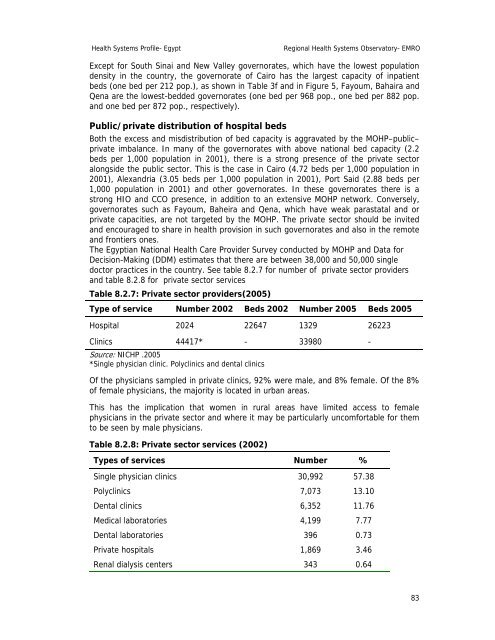Egypt : Complete Profile - What is GIS - World Health Organization
Egypt : Complete Profile - What is GIS - World Health Organization
Egypt : Complete Profile - What is GIS - World Health Organization
You also want an ePaper? Increase the reach of your titles
YUMPU automatically turns print PDFs into web optimized ePapers that Google loves.
<strong>Health</strong> Systems <strong>Profile</strong>- <strong>Egypt</strong> Regional <strong>Health</strong> Systems Observatory- EMRO<br />
Except for South Sinai and New Valley governorates, which have the lowest population<br />
density in the country, the governorate of Cairo has the largest capacity of inpatient<br />
beds (one bed per 212 pop.), as shown in Table 3f and in Figure 5, Fayoum, Bahaira and<br />
Qena are the lowest-bedded governorates (one bed per 968 pop., one bed per 882 pop.<br />
and one bed per 872 pop., respectively).<br />
Public/private d<strong>is</strong>tribution of hospital beds<br />
Both the excess and m<strong>is</strong>d<strong>is</strong>tribution of bed capacity <strong>is</strong> aggravated by the MOHP–public–<br />
private imbalance. In many of the governorates with above national bed capacity (2.2<br />
beds per 1,000 population in 2001), there <strong>is</strong> a strong presence of the private sector<br />
alongside the public sector. Th<strong>is</strong> <strong>is</strong> the case in Cairo (4.72 beds per 1,000 population in<br />
2001), Alexandria (3.05 beds per 1,000 population in 2001), Port Said (2.88 beds per<br />
1,000 population in 2001) and other governorates. In these governorates there <strong>is</strong> a<br />
strong HIO and CCO presence, in addition to an extensive MOHP network. Conversely,<br />
governorates such as Fayoum, Baheira and Qena, which have weak parastatal and or<br />
private capacities, are not targeted by the MOHP. The private sector should be invited<br />
and encouraged to share in health prov<strong>is</strong>ion in such governorates and also in the remote<br />
and frontiers ones.<br />
The <strong>Egypt</strong>ian National <strong>Health</strong> Care Provider Survey conducted by MOHP and Data for<br />
Dec<strong>is</strong>ion-Making (DDM) estimates that there are between 38,000 and 50,000 single<br />
doctor practices in the country. See table 8.2.7 for number of private sector providers<br />
and table 8.2.8 for private sector services<br />
Table 8.2.7: Private sector providers(2005)<br />
Type of service Number 2002 Beds 2002 Number 2005 Beds 2005<br />
Hospital 2024 22647 1329 26223<br />
Clinics 44417* - 33980 -<br />
Source: NICHP .2005<br />
*Single physician clinic. Polyclinics and dental clinics<br />
Of the physicians sampled in private clinics, 92% were male, and 8% female. Of the 8%<br />
of female physicians, the majority <strong>is</strong> located in urban areas.<br />
Th<strong>is</strong> has the implication that women in rural areas have limited access to female<br />
physicians in the private sector and where it may be particularly uncomfortable for them<br />
to be seen by male physicians.<br />
Table 8.2.8: Private sector services (2002)<br />
Types of services Number %<br />
Single physician clinics 30,992 57.38<br />
Polyclinics 7,073 13.10<br />
Dental clinics 6,352 11.76<br />
Medical laboratories 4,199 7.77<br />
Dental laboratories 396 0.73<br />
Private hospitals 1,869 3.46<br />
Renal dialys<strong>is</strong> centers 343 0.64<br />
83

















